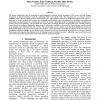Free Online Productivity Tools
i2Speak
i2Symbol
i2OCR
iTex2Img
iWeb2Print
iWeb2Shot
i2Type
iPdf2Split
iPdf2Merge
i2Bopomofo
i2Arabic
i2Style
i2Image
i2PDF
iLatex2Rtf
Sci2ools
LREC
2008
2008
Speech Errors on Frequently Observed Homophones in French: Perceptual Evaluation vs Automatic Classification
The present contribution aims at increasing our understanding of automatic speech recognition (ASR) errors involving frequent homophone or almost homophone words by confronting them to perceptual results. The long-term aim is to improve acoustic modelling of these items to reduce automatic transcription errors. A first question of interest is whether homophone words such as et, (and) and est (to be), for which ASR systems rely on language model weights, can be discriminated in a perceptual transcription test with similar n-gram constraints. A second question concerns the acoustic separability of the two homophone words using appropriate acoustic and prosodic attributes. The perceptual test reveals that even though automatic and perceptual errors correlate positively, human listeners in conditions attempting to approximate the information available for decision for a 4-gram language model deal with local ambiguity more efficiently than ASR systems. The corresponding acoustic analysis s...
| Added | 29 Oct 2010 |
| Updated | 29 Oct 2010 |
| Type | Conference |
| Year | 2008 |
| Where | LREC |
| Authors | Rena Nemoto, Ioana Vasilescu, Martine Adda-Decker |
Comments (0)

